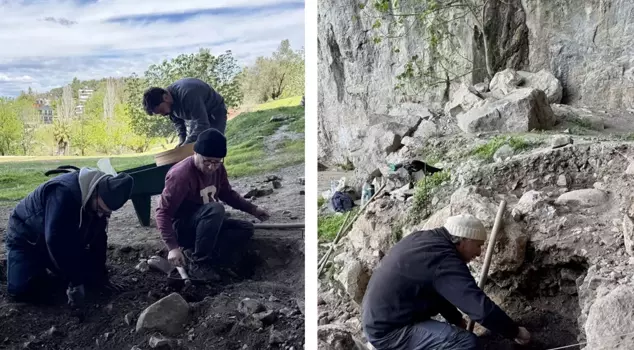
15.04.2025 18:44
In the Girmeler Mound Settlement located in the Seydikemer district of Muğla, where the first settlement dates back to 14,000 years ago, ancient DNA studies conducted on the skeletons found during excavations revealed the presence of 'early Anatolian genes.' It was stated that Girmeler is the ancestor of all early farming communities in Western Anatolia.
```html
In the Girmeler neighborhood of Seydikemer district in Muğla, excavation work is being carried out under the leadership of Prof. Dr. Taner Korkut and the field responsibility of Prof. Dr. Burçin Erdoğu, with the support of the Ministry of Culture and Tourism and Akdeniz University.
FIRST SETTLEMENT DATES BACK 14 THOUSAND YEARS
Stating that excavation work has been carried out at the base of the destroyed mound at the entrance and outside of the caves in Girmeler, excavation area responsible Prof. Dr. Erdoğu noted that the first settlement in Girmeler dates back to 14 thousand years ago, and their aim is to understand the cultural layers by identifying the earliest settlement strata.
"THEY ARE TRYING AGRICULTURE FOR THE FIRST TIME"
Prof. Dr. Erdoğu expressed that the findings in the Girmeler settlement reflect the process that can be considered the beginning of agriculture in Western Anatolia for the first time, saying: "It is understood that people living in round-planned huts in Girmeler in the 9th millennium BC tried agriculture for the first time. Despite being a hunter-gatherer society, it is understood that agriculture was also attempted. This process is very important because it is encountered for the first time in Western Anatolia. It was always assumed that there was a wave of migration from east to west and that the first settlements emerged in this region as a result of migration or colonization around 7000 BC. The Girmeler excavation completely changed this idea." Erdoğu emphasized that the people of Girmeler turned out to be the ancestors of almost all settled agricultural communities in Western Anatolia.
"WESTERN ANATOLIAN GENE FOUND"
Stating that they found graves belonging to the people living in Girmeler, Erdoğu said, "Ancient DNA studies were conducted on the skeletons in the Girmeler settlement, which has the oldest known skeletons in Western Anatolia to date. As a result of the ancient DNA studies conducted on these skeletons from this period, the early Anatolian gene was found."
"ANCESTORS OF THE FIRST FARMING COMMUNITIES"
Erdoğu explained that it has been revealed that the genes are similar to those found in the Pınarbaşı skeletons, known as the "Anatolian gene" in Central Anatolia, dating back to around 17 thousand years ago, stating that Girmeler is the ancestor of all the first farming communities in Western Anatolia. Erdoğu emphasized that Girmeler is also significant in terms of the transition to pottery and ceramic production for the first time, which is one of the firsts for Western Anatolia.
3 SPECIAL BUILDINGS REVEALED
Reporting that three special buildings have emerged at the edge of the Girmeler settlement, which are understood to have the ultimate purposes of meetings, ceremonies, and ritual activities, Erdoğu stated that these are terrazzo-based structures made by mixing small stone pieces with burnt lime, decorated with geometric or linear patterns. Erdoğu noted that one of these special structures contained burials, which is also a first for Western Anatolian archaeology.
```